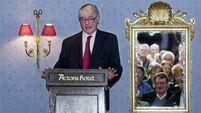Interconnector - Closer ties with nearest neighbour
The project, which begins commercial operations at the start of next month, involves the largest energy infrastructure built in this country since the opening of the Ardnacrusha Hydroelectric power station in 1929.
The interconnector involved the laying of 186km of undersea cable in a trench running from North Beach in Rush, Co Dublin, to Barkby Beach in northern Wales. A further 80km of cable was laid underground — 46km of which was from Rush to Batterstown — linking the two converter stations on either side of the Irish Sea.
EirGrid oversaw the project, which will allow for electricity to be bought and sold between Britain and Ireland. The scheme was developed on time and approximately €30m under the €600m budget. The EU provided a €110m grant for the project.
The interconnector should not only help to ensure supply in this country but also encourage the development of renewable energy sources here, because it expands the available market. There are also hopes it will help to lower this country’s electricity prices, which are well above the European average.
The interconnector has the capacity to carry 500 megawatts of electricity between the two countries — enough to power about 350,000 homes. The venture is another major step in the development of relations with our nearest neighbour.
Serious moves are already afoot to initiate another major project, the reopening of the long-closed 13km stretch of the Ulster Canal, which would link Clones with Lough Erne. This was one of the cross-border projects envisaged at the time of the Good Friday Agreement.
People on both sides of the border are excited about the business potential of this venture, which could have implications not only for the Clones area and its hinterland, but also for the whole island. It could provide for boats entering the waterway system at the Irish Sea to travel throughout most of the island, from places as far away as Coleraine and Belfast to Limerick and New Ross. It would have enormous tourist potential.
Yesterday Rory McIlroy began the final leg of his quest for the FedExCup with its $10m prize. He would be the first golfer from this island to win that prestigious prize, and we wish him the best of luck.
Controversy continues about whether he would compete for Britain or for Ireland at the 2016 Olympics. Part of the Good Friday Agreement recognises that people in the North are free to choose whether to be British or Irish.
While most people in this country would wish that each and every Northern sportsman would choose to compete for Ireland, the decision rests with each individual. We should not only respect that decision, but we should end any controversy now by making it clear we will support whatever decision Rory McIlroy makes. By doing so, we will be supporting the Good Friday Agreement.





